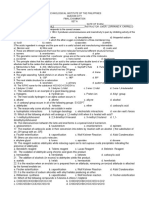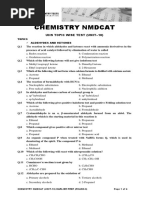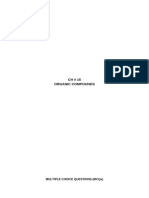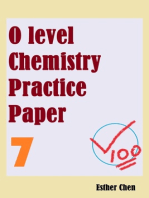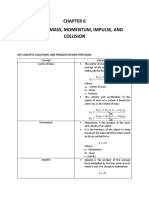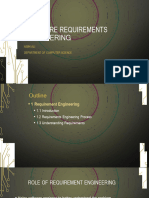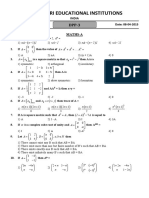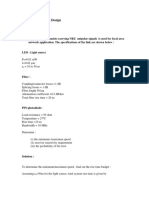0 ratings0% found this document useful (0 votes)
55 viewsOrganic Chemistry
Organic Chemistry
Uploaded by
Kim SeungminThe document provides 25 multiple choice questions related to organic chemistry concepts. The questions cover topics like functional groups, reactions involving alcohols and carbonyl compounds, addition and substitution reactions, and nomenclature of organic compounds.
Copyright:
© All Rights Reserved
Available Formats
Download as PDF, TXT or read online from Scribd
Organic Chemistry
Organic Chemistry
Uploaded by
Kim Seungmin0 ratings0% found this document useful (0 votes)
55 views2 pagesThe document provides 25 multiple choice questions related to organic chemistry concepts. The questions cover topics like functional groups, reactions involving alcohols and carbonyl compounds, addition and substitution reactions, and nomenclature of organic compounds.
Original Title
Organic-Chemistry
Copyright
© © All Rights Reserved
Available Formats
PDF, TXT or read online from Scribd
Share this document
Did you find this document useful?
Is this content inappropriate?
The document provides 25 multiple choice questions related to organic chemistry concepts. The questions cover topics like functional groups, reactions involving alcohols and carbonyl compounds, addition and substitution reactions, and nomenclature of organic compounds.
Copyright:
© All Rights Reserved
Available Formats
Download as PDF, TXT or read online from Scribd
Download as pdf or txt
0 ratings0% found this document useful (0 votes)
55 views2 pagesOrganic Chemistry
Organic Chemistry
Uploaded by
Kim SeungminThe document provides 25 multiple choice questions related to organic chemistry concepts. The questions cover topics like functional groups, reactions involving alcohols and carbonyl compounds, addition and substitution reactions, and nomenclature of organic compounds.
Copyright:
© All Rights Reserved
Available Formats
Download as PDF, TXT or read online from Scribd
Download as pdf or txt
You are on page 1of 2
GENERAL CHEMISTRY 1
7. The name of the saturated hydrocarbon
ORGANIC CHEMISTRY
isomer of cis-2-hexene is
a. 2-methyl-2-butene
1. Which of the following contains sp- b. 3-methyl-2-butene
hybridized carbon? c. 1,2-dimethylpropene
a. C4H8 d. None of the above
b. C3H6
c. C5H8 8. The acid-catalyzed addition of water to 1-
d. C6H12 butene will form
a. 1-butanol
2. Bond formed in the head-on overlap of two b. 2-butanol
orbitals c. Isopropyl alcohol
a. Sigma d. Propanol
b. Dative
c. Pi 9. Starting with 2-methyl-2-butene, which of
d. Double the following processes must be used to
produce a secondary alcohol?
3. Part of a molecule where most of its a. Acid-catalyzed hydration
chemical reactions occur b. Oxymercuration-demercuration
a. Single covalent c. Addition of bromine water
b. Double covalent d. Hydroboration-oxidation
c. Triple covalent
d. Functional group 10. Hydrogenation of alkynes in the presence of
a poisoned palladium catalyst produces
4. Which of the following molecules is a. Alkane
unsaturated? b. Alkyne
a. C3H8 c. Alcohol
b. CH3OH d. Alkene
c. C5H10
d. CH4 11. When 2-butyne undergoes ozonolysis, the
main product is
5. Which of the following alkanes is gas at room a. Carbon dioxide
temperature? b. Acetic acid
a. Octane c. Acetaldehyde
b. Propane d. Acetone
c. Eicosane
d. Undecane 12. How many isomers does xylene have?
a. 1
6. When ethyl bromide is treated with sodium b. 2
in dry ether, the product is c. 3
a. Propane d. 4
b. Butane
c. Methylpropane
d. Ethane
13. Vinylbenzene is also known as c. Esterification
a. Styrene d. Epoxidation
b. Cumene
c. Mesitylene 20. Cyclic esters are known as
d. Durene a. Acetals
b. Diglyme
14. Which of the following carbonyl compounds c. Lactones
produce a secondary alcohol with LiAlH4? d. Osazone
a. Aldehyde
b. Ketone 21. Which among the following is a ketone?
c. Ester a. CH3COOH
d. Carboxylic acid b. (CH3)2CHOH
c. CH3OCH2CH3
15. Addition of methyl magnesium bromide to d. CH3CHO
acetaldehyde produces
a. Ethanol 22. Hexanedioic acid is also known as
b. 1-propanol a. Malonic acid
c. Methanol b. Succinic acid
d. 2-propanol c. Glutaric acid
d. Adipic acid
16. Oxidation of isopropyl alcohol with KMnO4
will yield 23. With the same molecular weight, a
a. Acetone carboxylic acid will have a/an _____ boiling
b. Acetaldehyde point than an alcohol
c. Acetic acid a. Lower
d. Diethyl ether b. Equal
c. Higher
17. Which of the following tests will distinguish d. No basis
1-propanol from 2-propanol?
a. Fehling’s test 24. All of the following are ortho and para
b. Tollen’s test directing substituents except
c. Benedict’s test a. -OH
d. Lucas test b. -F
c. -OR
18. Acid anhydrides upon hydrolysis yield d. -NO2
a. Esters
b. Amides 25. A tertiary alcohol is produced using Grignard
c. Carboxylic acid Reagent using a/an
d. Acyl halide a. Ketone
b. Aldehyde
19. Reaction of alcohol and a carboxylic acid is c. Alkyl halide
known as d. Epoxides
a. Saponification
b. Neutralization
You might also like
- Dome Geodésico Tipo TunelDocument11 pagesDome Geodésico Tipo TunelAiran BertinettiNo ratings yet
- Organic ChemistryDocument36 pagesOrganic ChemistryPepy PeachNo ratings yet
- Review Questions and ProblemsDocument6 pagesReview Questions and Problemsmache dumadNo ratings yet
- 12 - TPP - Aliphatic HydrocarbonsDocument2 pages12 - TPP - Aliphatic HydrocarbonsSaadia AsgharNo ratings yet
- Competency Exam in Organic ChemistryDocument4 pagesCompetency Exam in Organic ChemistryRaymond Yabut100% (1)
- 04 Chemistry Unit-10 (Student Copy)Document4 pages04 Chemistry Unit-10 (Student Copy)Kamran ShabbirNo ratings yet
- Aldehyde 5Document6 pagesAldehyde 5bujjjitamilNo ratings yet
- 12 - Aliphatic Hydrocarbons (PS)Document8 pages12 - Aliphatic Hydrocarbons (PS)humaaot7No ratings yet
- ORGANIC ACT 3_EXAMDocument4 pagesORGANIC ACT 3_EXAMMary Mae VitorNo ratings yet
- Organic Chemistry Board Exam Questions PDFDocument10 pagesOrganic Chemistry Board Exam Questions PDFDonPedrewNo ratings yet
- SSS 3 Second Term ExaminationDocument7 pagesSSS 3 Second Term Examinationmayowaednut100% (1)
- Medical Colleges of Northern PhilippinesDocument8 pagesMedical Colleges of Northern PhilippinesJerrypol Casil PalmaNo ratings yet
- Orgchem 2nd TermDocument7 pagesOrgchem 2nd Termsophia del rosarioNo ratings yet
- Tick The Correct Option.: Chemistry Entry Test MCAT By: Sagheer Ahmad Gudara M.Phill ChemistryDocument4 pagesTick The Correct Option.: Chemistry Entry Test MCAT By: Sagheer Ahmad Gudara M.Phill ChemistrykamranNo ratings yet
- High School 2 Worksheet Question Ans 09-22Document7 pagesHigh School 2 Worksheet Question Ans 09-22Jasmina DezmicNo ratings yet
- Module 1 3Document9 pagesModule 1 3Alkiana SalardaNo ratings yet
- Chapter No. 18 Alcohols Phenols & Ethers McqsDocument2 pagesChapter No. 18 Alcohols Phenols & Ethers McqsAbdul Qayyum100% (1)
- Organic Chemistry Q&A - 1Document4 pagesOrganic Chemistry Q&A - 1Abaring KathrynaNo ratings yet
- Organic Chemistry 2: (I) RMGBR (Ii) H /H ODocument3 pagesOrganic Chemistry 2: (I) RMGBR (Ii) H /H OarielNo ratings yet
- Chemistry 2nd YearDocument6 pagesChemistry 2nd YearAaqib AliNo ratings yet
- TEST-7 ELITE (C-7&8)Document2 pagesTEST-7 ELITE (C-7&8)tarunmathur7777No ratings yet
- Grade 10 ChemDocument6 pagesGrade 10 ChemDegu DegaregNo ratings yet
- Competency Exam in Organic ChemistryDocument3 pagesCompetency Exam in Organic ChemistryWinsletJoyDauagNo ratings yet
- Assignment Sir Yasir Chemistry CH # 18Document2 pagesAssignment Sir Yasir Chemistry CH # 18Yasir QureshiNo ratings yet
- D0597551 CHEM12 C2300 CTBS MigDocument5 pagesD0597551 CHEM12 C2300 CTBS MigHitman KillerNo ratings yet
- Organic Part Full Length PaperDocument4 pagesOrganic Part Full Length PaperChemistry guideNo ratings yet
- XII Chemistry Chapter 08 2Document10 pagesXII Chemistry Chapter 08 2aqsa15873No ratings yet
- 04-W-4 ChemistryDocument9 pages04-W-4 Chemistryzain IshaqNo ratings yet
- Chemistry Nmdcat: Uhs Topic Wise Test (Unit-10)Document4 pagesChemistry Nmdcat: Uhs Topic Wise Test (Unit-10)Saad Arsalan100% (1)
- CHEM 132 QUESTIONS - 3Document5 pagesCHEM 132 QUESTIONS - 3Amina bello KokoNo ratings yet
- HALOALKANES AND HALOARENES ( 5 OCT )Document4 pagesHALOALKANES AND HALOARENES ( 5 OCT )Amandeep KaurNo ratings yet
- Aldehyde 4Document4 pagesAldehyde 4bujjjitamilNo ratings yet
- 10th CHMDocument1 page10th CHMzeeshanhameedz1996No ratings yet
- Chemistry 2nd Year Question Bank CH#8Document2 pagesChemistry 2nd Year Question Bank CH#8rohmashahid69No ratings yet
- (MCQ 32) Hydrocarbons +2 Chem MCQDocument5 pages(MCQ 32) Hydrocarbons +2 Chem MCQyojittiwari73No ratings yet
- Aldehyde-and-ketone-2081 (1)Document3 pagesAldehyde-and-ketone-2081 (1)kabitlove4familyNo ratings yet
- CHemistry mock AND SS2 SECOND TERMDocument16 pagesCHemistry mock AND SS2 SECOND TERMTAOFEEK ORIYOMINo ratings yet
- Chapter 3 MCQs (Unsolved)Document4 pagesChapter 3 MCQs (Unsolved)Zeeshan SattarNo ratings yet
- مراجعة الفاينال تحليلية اولي 2024Document12 pagesمراجعة الفاينال تحليلية اولي 2024alaa1u260No ratings yet
- Q-1 - Retest - Med II - 2020Document2 pagesQ-1 - Retest - Med II - 2020Kashmira WeerasekaraNo ratings yet
- OXIDATION AND REDUCTION OF CARBONYL COMPOUNDSDocument4 pagesOXIDATION AND REDUCTION OF CARBONYL COMPOUNDSAmandeep KaurNo ratings yet
- Chapter 2 Form5Document9 pagesChapter 2 Form5Zulkifli Bin Pari100% (1)
- Reviewer in Genchem Final CoverageDocument18 pagesReviewer in Genchem Final CoveragelaffytopinspironNo ratings yet
- SCH3U - Practice ExamDocument9 pagesSCH3U - Practice ExamWaqas AhmadNo ratings yet
- Aldehyde Ketone Carboxylic Acid pt1Document2 pagesAldehyde Ketone Carboxylic Acid pt1Dharmvir TantyNo ratings yet
- MCQ 11Document8 pagesMCQ 11PqrtsNo ratings yet
- Organic Chemistry Practice Test 2B: 10 Items - 15 MinutesDocument1 pageOrganic Chemistry Practice Test 2B: 10 Items - 15 MinutesJelo LacernaNo ratings yet
- Organic Chemistry Mock Exam (ANSWER KEY)Document7 pagesOrganic Chemistry Mock Exam (ANSWER KEY)k.talle039100% (1)
- SC2 - O'Malley SAT II Review (Organic)Document2 pagesSC2 - O'Malley SAT II Review (Organic)Rajiv KabadNo ratings yet
- NED Past Papers 2003Document4 pagesNED Past Papers 2003hussainayub6936No ratings yet
- Chemistry-Xii (Chapter-06) - 2Document9 pagesChemistry-Xii (Chapter-06) - 2kanayalal184No ratings yet
- Day1 CompiledDocument39 pagesDay1 CompiledWinsletJoyDauagNo ratings yet
- 9 11Document1 page9 11hassan tariqNo ratings yet
- CH # 15 Organic CompounsDocument9 pagesCH # 15 Organic Compounsahseya220No ratings yet
- ReviewerDocument6 pagesReviewerMariAntonetteChangNo ratings yet
- namma_kalvi_12th_chemsitry_unit_12_study_material_english_medium_216129Document29 pagesnamma_kalvi_12th_chemsitry_unit_12_study_material_english_medium_216129codofficial61No ratings yet
- Haloalkane Imp QurstionsDocument4 pagesHaloalkane Imp QurstionsMohit BistaNo ratings yet
- PDocument7 pagesPsudhanshu0835.2No ratings yet
- Chemistry Sma 2: FINAL EXAM SEM-2 2013/2014Document3 pagesChemistry Sma 2: FINAL EXAM SEM-2 2013/2014Arda RahmainiNo ratings yet
- Sample Questions For S.Y.B.Pharm Sem III CBCS R 2019 OC II ATKT ExamsDocument4 pagesSample Questions For S.Y.B.Pharm Sem III CBCS R 2019 OC II ATKT Examsshrutinavrang29No ratings yet
- Measurement and Vectors: Key Concepts, Equations, and Problem Solving StrategiesDocument6 pagesMeasurement and Vectors: Key Concepts, Equations, and Problem Solving StrategiesKim SeungminNo ratings yet
- Q2 Personal Development 12 - Module 3Document21 pagesQ2 Personal Development 12 - Module 3Kim Seungmin100% (1)
- General Physics 1 (W6)Document6 pagesGeneral Physics 1 (W6)Kim SeungminNo ratings yet
- General Physics 1 (W5)Document5 pagesGeneral Physics 1 (W5)Kim SeungminNo ratings yet
- General Physics 1 (W4)Document7 pagesGeneral Physics 1 (W4)Kim SeungminNo ratings yet
- PE and Health 3: Festival DancesDocument17 pagesPE and Health 3: Festival DancesKim Seungmin100% (1)
- Software Requirements EngineeringDocument45 pagesSoftware Requirements Engineeringwikiy72731No ratings yet
- Estimate and MeasureDocument53 pagesEstimate and MeasureChynaZSosaNo ratings yet
- Cleanroom Energy EfficiencyDocument6 pagesCleanroom Energy EfficiencysdvitkoNo ratings yet
- Free Fall ReportDocument8 pagesFree Fall ReportwanzalezNo ratings yet
- Bitsat DPP-3 DT 08-04-2015Document8 pagesBitsat DPP-3 DT 08-04-2015Phani KumarNo ratings yet
- Science and Math Equipment For Grade 7 To 12 Report 2019-2020Document27 pagesScience and Math Equipment For Grade 7 To 12 Report 2019-2020JUVELYN BELLITANo ratings yet
- Expert Systems TutorialDocument8 pagesExpert Systems TutorialKuganeswara Sarma AatithanNo ratings yet
- November 05 V MSDocument3 pagesNovember 05 V MSVarun PanickerNo ratings yet
- Din en 13230-3 - 2016-11Document2 pagesDin en 13230-3 - 2016-11boubakerNo ratings yet
- Mathematical Model of The PMSG Based On Wind Energy Conversion SystemDocument7 pagesMathematical Model of The PMSG Based On Wind Energy Conversion SystemIRJIENo ratings yet
- Important Topics For Placements - Core ElectronicsDocument6 pagesImportant Topics For Placements - Core ElectronicsSandeep VermaNo ratings yet
- Lecture 3 - Solving Non-Linear Equations (BiSection)1Document20 pagesLecture 3 - Solving Non-Linear Equations (BiSection)1mahmoudtaha6548No ratings yet
- Assignment 2 (Digital Logic) PDFDocument8 pagesAssignment 2 (Digital Logic) PDFsharminiNo ratings yet
- PRS Imanager Introduction and Key FeaturesDocument83 pagesPRS Imanager Introduction and Key FeaturesArielNo ratings yet
- Servicing IBM Systems X Servers II - Study GuideDocument154 pagesServicing IBM Systems X Servers II - Study GuideMircea GavrilaNo ratings yet
- Xpath CheatsheetDocument10 pagesXpath CheatsheetdfasdfasdfasdfsNo ratings yet
- AutoCad Plugin For 3D Coal Seam ModelDocument26 pagesAutoCad Plugin For 3D Coal Seam Modelcena starNo ratings yet
- AfsDocument2 pagesAfsNovei Almane GorresNo ratings yet
- Time Series Analysis and ForecastingDocument36 pagesTime Series Analysis and ForecastingAdrian PetcuNo ratings yet
- Experiment 1 Familiarization With Electrical Measuring InstrumentsDocument10 pagesExperiment 1 Familiarization With Electrical Measuring InstrumentsCorps LaroprocNo ratings yet
- Thermal SensorDocument22 pagesThermal SensorJesmine GandhiNo ratings yet
- Huawei OptiX OSN 6800/3800 Optical Transponder Board ECOM DocumentDocument26 pagesHuawei OptiX OSN 6800/3800 Optical Transponder Board ECOM DocumentThunder-Link.comNo ratings yet
- Gunnar Goes PillagingDocument47 pagesGunnar Goes PillagingFranklin PetersonNo ratings yet
- Stress AnalysisDocument18 pagesStress Analysisrasif88718100% (1)
- Cheat Sheet AngularDocument15 pagesCheat Sheet AngularSandeep TeotiaNo ratings yet
- TN70 Sow Feeding and ManagementDocument8 pagesTN70 Sow Feeding and Managementthanh ba matNo ratings yet
- OFC Design ExamplesDocument8 pagesOFC Design Examplesbkmmizan0% (1)
- Ansi Radition N42-35Document38 pagesAnsi Radition N42-35Harish Gupta (JSHL)No ratings yet
- 4. CLUTCH & GEAR BOX_PPTDocument119 pages4. CLUTCH & GEAR BOX_PPTshyambhimani.tmrNo ratings yet






















